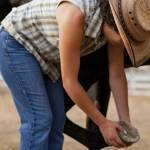Seedy Toe in Horses: Nutrition Helps Hoof Health

Seedy toe, also called white line disease, is a separation of the outer wall from the sole of a horse’s hoof. This separation occurs as a result of opportunistic bacteria or fungi that invade the hoof when it is compromised. Organisms feed on live tissue within the hoof, destroying it little by little.
A hoof can become compromised for a variety of reasons: laminitic episodes, irregular blood flow, infection, abnormal hoof conformation, or improper hoof trimming causing undue stress in the hoof.
Experienced farriers should recognize seedy toe before lameness occurs. During a routine trim, a farrier will typically notice a widened, chalky region where the sole and hoof wall connect. Once seedy toe has been identified, a farrier or veterinarian will determine the severity of tissue damage in the hoof and formulate an action plan.
Except in very minor cases, the hoof wall will have to be removed, a procedure called resection, and the underlying tissue debrided to reveal the damage. Bacteria and fungi implicated in seedy toe are sensitive to light and air, which is why all disease tissue is removed and the hoof left unwrapped.
Hooves with large areas of resection should be supported by corrective farrier work and trimmed every few weeks to promote healthy hoof conformation. The disease, especially if it has been undiagnosed for some time, may have caused abnormal hoof growth. A farrier may choose to shoe a horse with white line disease to help support the entire structure of the hoof after resection. An easy, effective way to do this is by placing an ordinary horseshoe backward on the hoof, such that the rounded toe of the shoe supports the heels. Other shoeing approaches may also help in healing diseased hooves, and a farrier will know how best to proceed.
Nutritional well-being plays a role in sound hoof growth. A horse’s diet should be evaluated to be sure all pertinent nutrients are being fed in appropriate amounts. Of particular note, horses should receive complete fortification of vitamins and minerals. A biotin supplement can be added to the diet to promote hoof wall growth. Bio-Bloom PS (Bio-Bloom HF in Australia), a prescription-strength feed supplement with biotin, methionine, iodine, and chelated zinc, will aid in the development of strong hoof wall.
Avoiding white line disease requires diligent care. Keep these in mind:
- Pick out hooves daily, especially during periods of heavy moisture or drought to discourage bacteria and fungi from taking hold in the tissue.
- Contact a farrier immediately if any breach in the white line is noticed, especially if the junction between wall and sole is unusually soft or spongy.
- Work closely with both a veterinarian and farrier to eradicate any sign of the disease as soon as it’s noticed. The earlier an instance of seedy toe is caught, the easier it is to prevent long-term damage to the hoof.








